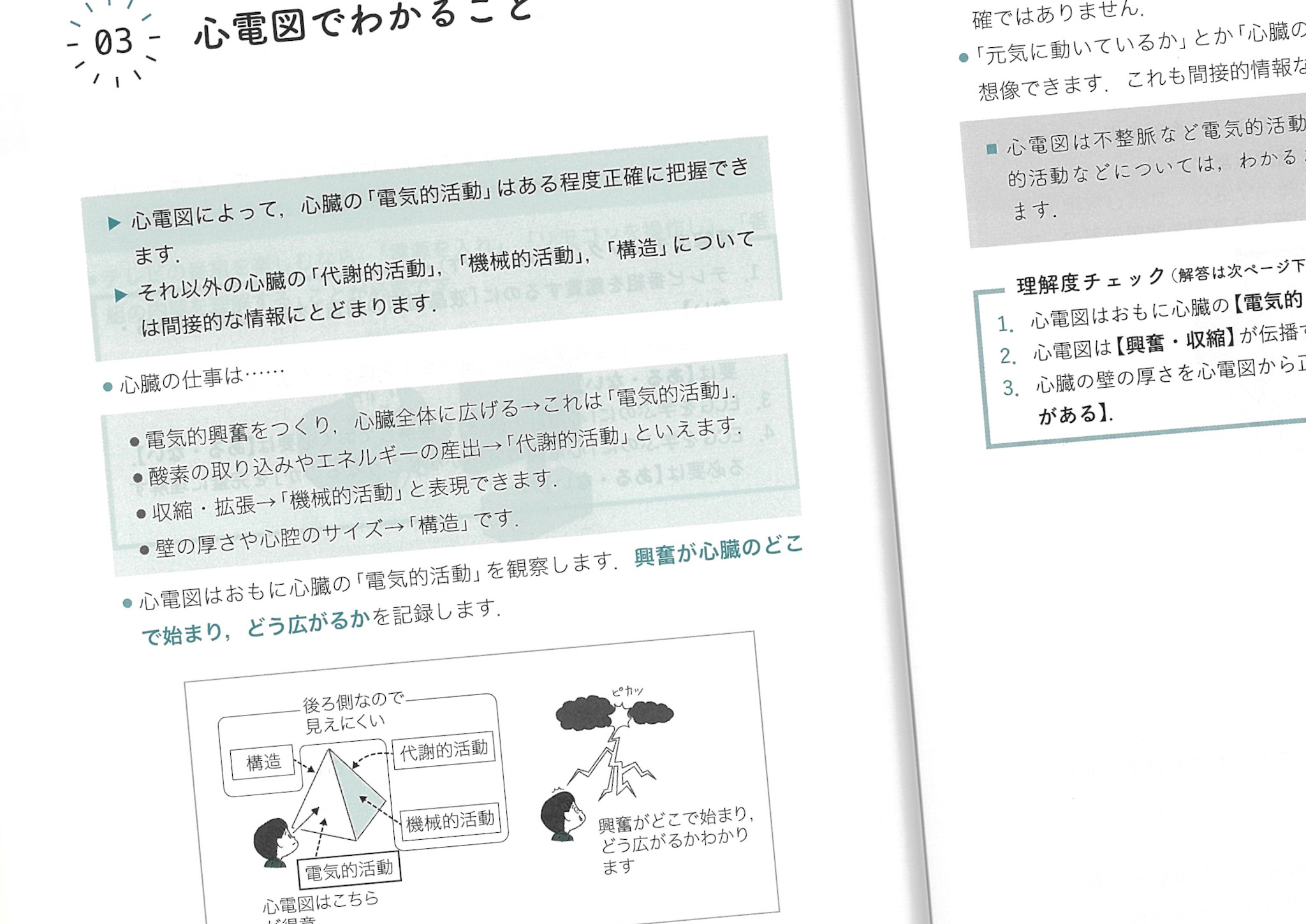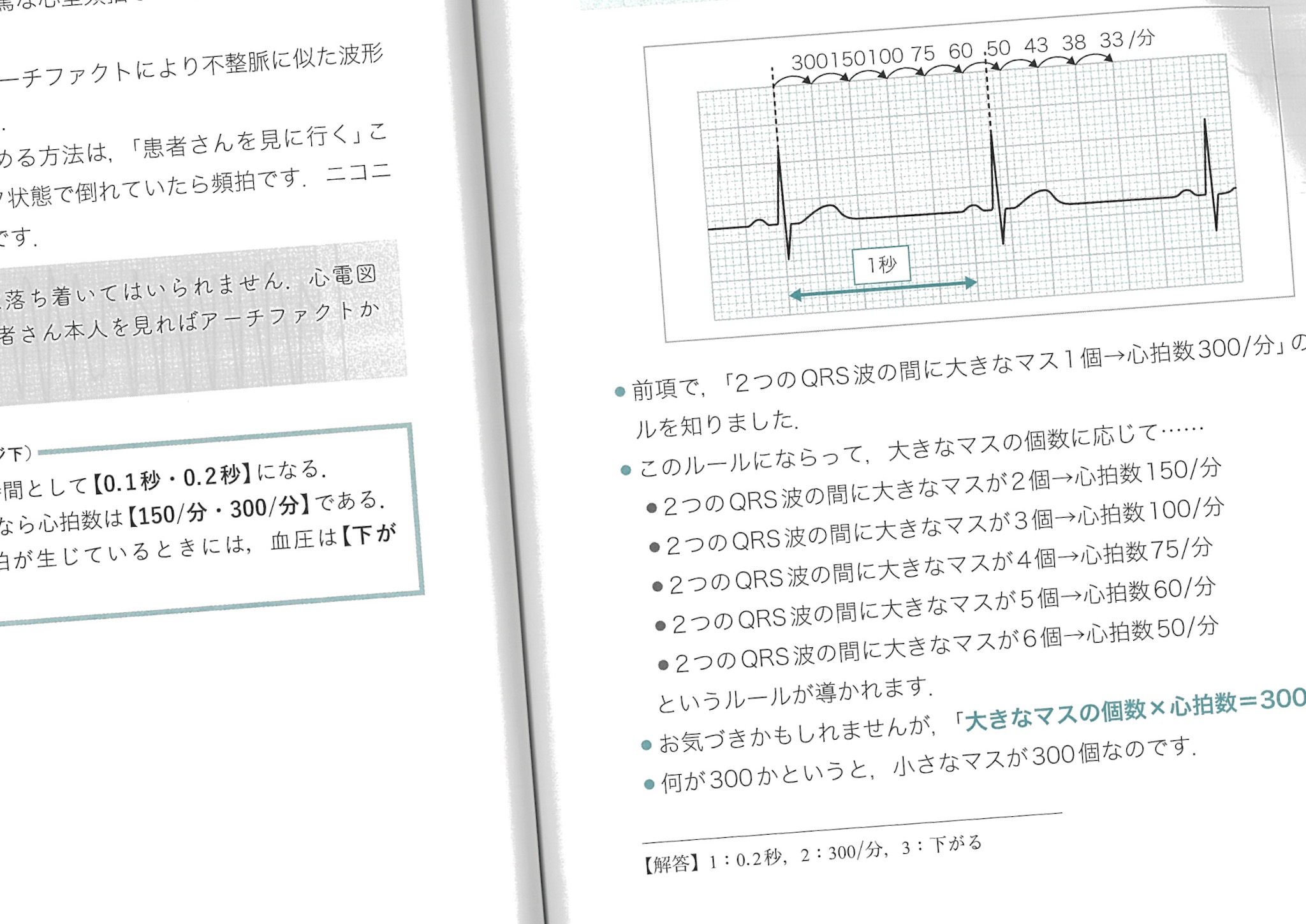ほぼ初めての心電図: 最初はここからはじまります

医学生や研修医に向けた、心電図診断のテキスト。
特徴は、短時間で実務に耐える心電図の知識を概観できること。5時間あれば通読できるようになっているらしい。そのために、学ぶべきことを用心深く選んである。
何かを勉強するとき、理屈の沼にハマらないように「この先危険」と教えてくれるメンターがいると助かる。そして「実は本人もわかってないんじゃないの?」と疑われてしまうようではいけないので、メンター自身はちゃんとした理論家であってほしい。本書はそういうメンターの代わりになるだろう。5時間を読書に使ってみよう。本当に全く心電図がはじめてということはないだろうから(生理学で膜電位からやった)、知っているところも多くあるはず。
実際に読んでみると、さすがに連続5時間ではムリな気がするが、何日かに分けたらいけると思う。最初は簡単なので読み飛ばしながらサッと進めるが、あとになると難しさは増し、ちょっとくたびれてくる。計画は無理なく、あとになるほど余裕を持って。
同様のスタンスの本を最近レビューした。『心電図の読み方やさしくやさしく教えます』。立ち読みして気に入った方で勉強したらいいと思う。
全体が、3つのパートに分かれていて、それぞれがいくつかの章にわかれている。
A.心臓の活動と電位
第1章 心電図とは
01 心電図とは何ですか
02 心電図を学ぶときに必要なこと
……
B.基本的な心電図の所見と異常
第4章 脚ブロック
01 心室の刺激伝導系─右脚と左脚
02 右脚ブロックの12 誘導心電図
…
第5章 電気軸
01 心室の電気軸
02 電気軸の正常値
……
C.心電図を読む
第13章 心電図が体に染みこむ練習問題
01 心電図が体に染みこむ練習問題
解答と解説
ひとつめのパートが「心臓の活動と電位」。
学び方の心得がまずある。根を詰めすぎないこと。勉強を止めるポイントをハッキリさせておかないと、勉強を完了できない。
心電図でできること・できないことがまず書いてあって、ありがたい。心電図の立派な本を見ると、心膜炎とかファロー四徴症とかもでてくるわけで、そんなのまで心電図で読めないといけないの? とモチベーションが下がる。そこは心電図より先にエコーでしょうよ、といってもらえたら、悩まずに済むというものだ。
心筋の電気生理も、一応の説明はある。生理学の授業をかつてやり過ごせていたら、だいじょうぶだろう。
本来詳細な理論をふりかざさないと理解できないことは、たとえ話を多用している。わかった気になってやり過ごす方便だ。ときにはたとえがかけ離れすぎていて、分かったような分からないような多分何もわからない部分もある。そういうところは目を細めて読み飛ばそう。
膜電位の数式が出てこない代わりに、ドレッシングの例えがあった。でも全くわからなかった。エントロピー? 位置エネルギー? Na-K ATPaseはどれ? まあ、電気生理学の試験にドレッシングで答えない方がいいとは思う。
このイラストと一番近い容器は、iL-Chianti(イル キャンティ)だろうか。TMI
壁の内腔面が先に収縮するという、アドバンストだけど重要な話しはちゃんとしてある。補足すると、先に内腔側が収縮しとけば、外面側が収縮するときの機械抵抗にならないのである。
チラ見で心電図をよむための最低限覚えておくこと、最低限覚えておく数値は、繰り返しでてくる。たとえば、心電図の方眼の太枠(5mm四方)、横が0.2秒で、縦が0.5mV、RRが5mmなら300/秒、など。こういうのは、練習でみにつけるのだろう。
トリビア的なこと、歴史的な経緯でスッキリしてないこと、などもある。勉強していると、疑問だったり、面倒に思うポイントだ。
2つめのパートが、基本的な心電図の所見と異常。ここから心疾患が出てくる。本書のコアになる部分だ。
心電図の診断価値の高い病態、不整脈、虚血、心肥大だ。これ以外の心疾患、弁膜症や心筋炎、心膜炎などは、心電図より先にエコー、血液検査、造影の段取りをすることになる。
読み進むと話しがむずかしくなってくるが、とりあえず使えるようなパールを出してくれる。
最後のパートは練習問題。
AIが入ってきたりすると、心電計の自動診断で十分使えるようになるのではないか。本書でもしばしば言及されるとおり、べつに心電図だけで心臓病が診断できるわけでない。例えば心電図に頻脈っぽいのがでたとき、ノイズを鑑別するまでもなく患者の様子に注意したらわかる。
心電図のAI診断の文献をみてみよう。
再灌流の必要な状態の予測の確度を評価した研究と、心房細動の判定とを評価した研究がある。いずれも、AUC(C統計量;予測能を測る統計値、偶然なら0.5、完全に正確なら1)が0.9近い。心電図だけを見てこれだけ正確に言い当てるには、どれだけ修行をしないといけないのだろうか。そんな時間があったら、エコーの練習をした方がいい気がする。
Artificial intelligence to predict needs for urgent revascularization from 12-leads electrocardiography in emergency patients
Shinichi Goto, Mai Kimura, Yoshinori Katsumata, Shinya Goto, Takashi Kamatani, Genki Ichihara, Seien Ko, Junichi Sasaki, Keiichi Fukuda, Motoaki Sano
Patient with acute coronary syndrome benefits from early revascularization. However, methods for the selection of patients who require urgent revascularization from a variety of patients visiting the emergency room with chest symptoms is not fully established. Electrocardiogram is an easy and rapid procedure, but may contain crucial information not recognized even by well-trained physicians. To make a prediction model for the needs for urgent revascularization from 12-lead electrocardiogram recorded in the emergency room. We developed an artificial intelligence model enabling the detection of hidden information from a 12-lead electrocardiogram recorded in the emergency room. Electrocardiograms obtained from consecutive patients visiting the emergency room at Keio University Hospital from January 2012 to April 2018 with chest discomfort was collected. These data were splitted into validation and derivation dataset with no duplication in each dataset. The artificial intelligence model was constructed to select patients who require urgent revascularization within 48 hours. The model was trained with the derivation dataset and tested using the validation dataset. Of the consecutive 39,619 patients visiting the emergency room with chest discomfort, 362 underwent urgent revascularization. Of them, 249 were included in the derivation dataset and the remaining 113 were included in validation dataset. For the control, 300 were randomly selected as derivation dataset and another 130 patients were randomly selected for validation dataset from the 39,317 who did not undergo urgent revascularization. On validation, our artificial intelligence model had predictive value of the c-statistics 0.88 (95% CI 0.84–0.93) for detecting patients who required urgent revascularization. Our artificial intelligence model provides information to select patients who need urgent revascularization from only 12-leads electrocardiogram in those visiting the emergency room with chest discomfort.
PLoS ONE 2019 https://dx.doi.org/10.1371/journal.pone.0210103
An artificial intelligence-enabled ECG algorithm for the identification of patients with atrial fibrillation during sinus rhythm: a retrospective analysis of outcome prediction
Zachi I Attia, Peter A Noseworthy, Francisco Lopez-Jimenez, Samuel J Asirvatham, Abhishek J Deshmukh, Bernard J Gersh, Rickey E Carter, Xiaoxi Yao, Alejandro A Rabinstein, Brad J Erickson, Suraj Kapa, Paul A Friedman
Background Atrial fibrillation is frequently asymptomatic and thus underdetected but is associated with stroke, heart failure, and death. Existing screening methods require prolonged monitoring and are limited by cost and low yield. We aimed to develop a rapid, inexpensive, point-of-care means of identifying patients with atrial fibrillation using machine learning. Methods We developed an artificial intelligence (AI)-enabled electrocardiograph (ECG) using a convolutional neural network to detect the electrocardiographic signature of atrial fibrillation present during normal sinus rhythm using standard 10-second, 12-lead ECGs. We included all patients aged 18 years or older with at least one digital, normal sinus rhythm, standard 10-second, 12-lead ECG acquired in the supine position at the Mayo Clinic ECG laboratory between Dec 31, 1993, and July 21, 2017, with rhythm labels validated by trained personnel under cardiologist supervision. We classified patients with at least one ECG with a rhythm of atrial fibrillation or atrial flutter as positive for atrial fibrillation. We allocated ECGs to the training, internal validation, and testing datasets in a 7:1:2 ratio. We calculated the area under the curve (AUC) of the receiver operatoring characteristic curve for the internal validation dataset to select a probability threshold, which we applied to the testing dataset. We evaluated model performance on the testing dataset by calculating the AUC and the accuracy, sensitivity, specificity, and F1 score with two-sided 95% CIs. Findings We included 180 922 patients with 649 931 normal sinus rhythm ECGs for analysis: 454 789 ECGs recorded from 126 526 patients in the training dataset, 64 340 ECGs from 18 116 patients in the internal validation dataset, and 130 802 ECGs from 36 280 patients in the testing dataset. 3051 (8·4%) patients in the testing dataset had verified atrial fibrillation before the normal sinus rhythm ECG tested by the model. A single AI-enabled ECG identified atrial fibrillation with an AUC of 0·87 (95% CI 0·86–0·88), sensitivity of 79·0% (77·5–80·4), specificity of 79·5% (79·0–79·9), F1 score of 39·2% (38·1–40·3), and overall accuracy of 79·4% (79·0–79·9). Including all ECGs acquired during the first month of each patient’s window of interest (ie, the study start date or 31 days before the first recorded atrial fibrillation ECG) increased the AUC to 0·90 (0·90–0·91), sensitivity to 82·3% (80·9–83·6), specificity to 83·4% (83·0–83·8), F1 score to 45·4% (44·2–46·5), and overall accuracy to 83·3% (83·0–83·7). Interpretation An AI-enabled ECG acquired during normal sinus rhythm permits identification at point of care of individuals with atrial fibrillation. Funding None.
The Lancet 2019 https://dx.doi.org/10.1016/s0140-6736(19)31721-0
本書は、キャンペーンの景品でいただいた。医学書の出版社のツイッターをフォローしていると、たまにいいことがあるかもしれない。













